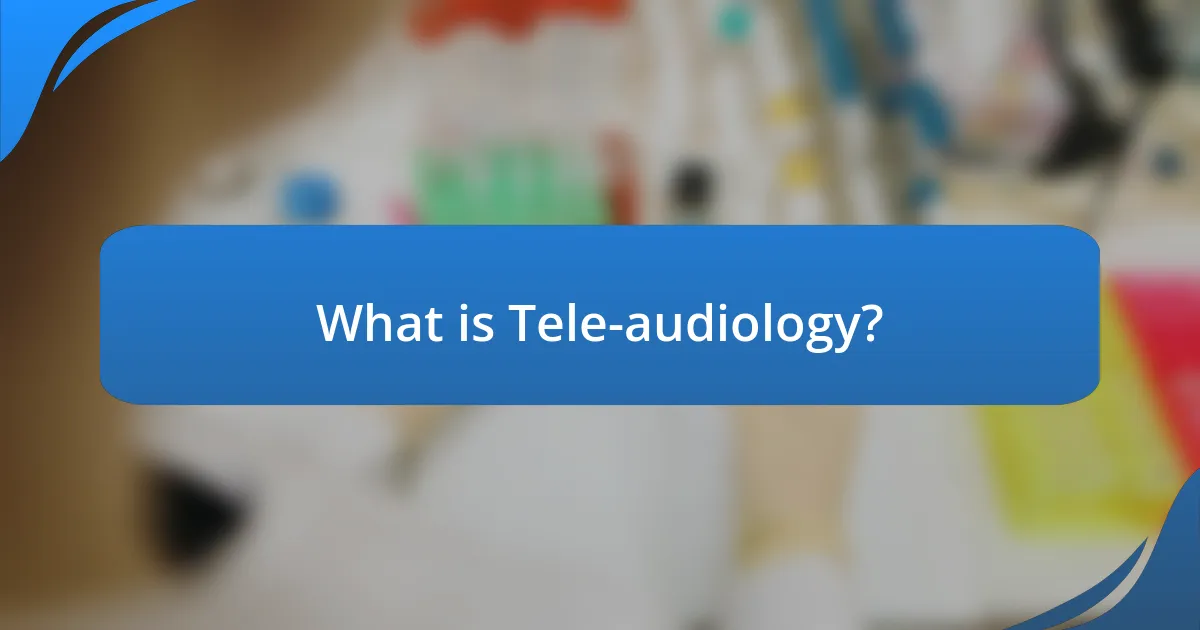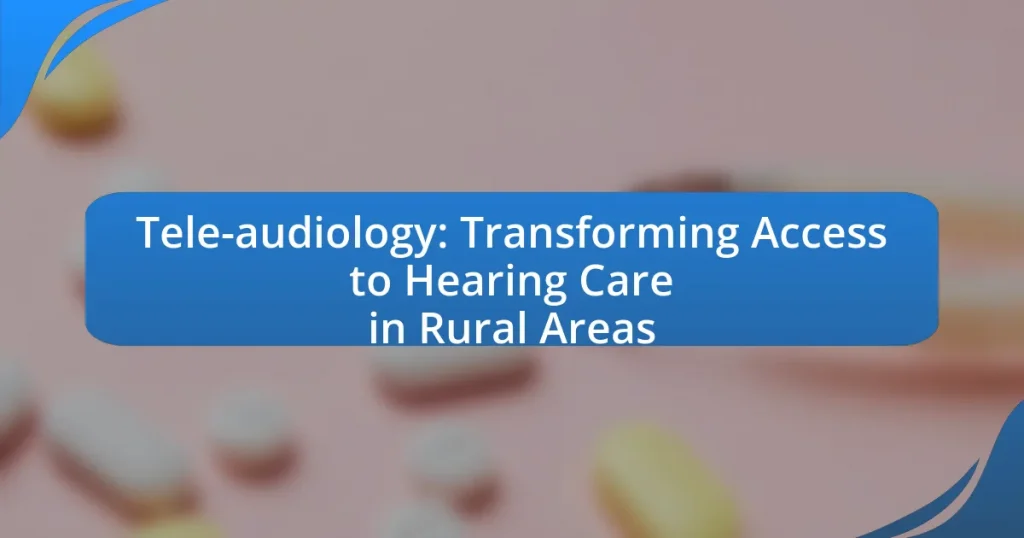Tele-audiology is a branch of telehealth that delivers audiological services remotely, utilizing telecommunications technology to enhance access to hearing care, particularly in rural and underserved areas. This article explores how tele-audiology functions, the essential technologies involved, and the types of remote assessments that can be conducted. It also addresses the challenges tele-audiology overcomes in rural healthcare, the benefits it provides, and the evidence supporting its effectiveness. Additionally, the article discusses best practices for implementation, training for audiologists, and resources available for patients, highlighting the transformative impact of tele-audiology on access to hearing care.

What is Tele-audiology?
Tele-audiology is a branch of telehealth that provides audiological services remotely using telecommunications technology. This approach allows audiologists to conduct assessments, provide consultations, and deliver follow-up care to patients, particularly in rural or underserved areas where access to traditional audiology services may be limited. Studies have shown that tele-audiology can effectively improve access to hearing care, with research indicating that remote consultations yield similar outcomes to in-person visits, thereby enhancing patient satisfaction and adherence to treatment plans.
How does Tele-audiology function in rural areas?
Tele-audiology functions in rural areas by utilizing digital communication technologies to provide remote audiological services. This approach allows audiologists to conduct assessments, offer consultations, and deliver follow-up care without the need for patients to travel long distances. Studies indicate that tele-audiology can significantly improve access to hearing care, with a report from the American Journal of Audiology showing that 90% of rural patients found tele-audiology services to be effective and convenient. By bridging geographical barriers, tele-audiology enhances the availability of specialized hearing care in underserved regions.
What technologies are essential for Tele-audiology?
Essential technologies for Tele-audiology include high-speed internet, telecommunication software, audiometric equipment, and remote patient monitoring tools. High-speed internet enables real-time audio and video communication, which is crucial for remote consultations. Telecommunication software facilitates virtual appointments and secure data sharing between audiologists and patients. Audiometric equipment, such as portable hearing tests, allows for accurate assessments in a home setting. Remote patient monitoring tools help track patient progress and hearing aid usage, ensuring effective ongoing care. These technologies collectively enhance access to hearing care, particularly in rural areas where traditional services may be limited.
How do these technologies facilitate remote hearing assessments?
Technologies facilitate remote hearing assessments by enabling audiologists to conduct evaluations through digital platforms, allowing patients to receive care from their homes. These technologies include telecommunication tools, mobile applications, and specialized software that support real-time audio and video interactions, ensuring accurate assessments. For instance, studies have shown that remote audiometric testing can yield results comparable to in-person evaluations, demonstrating the effectiveness of these technologies in maintaining diagnostic accuracy.
What are the key components of Tele-audiology services?
The key components of Tele-audiology services include remote hearing assessments, virtual consultations, and the use of digital technology for hearing aid fittings and adjustments. Remote hearing assessments allow audiologists to evaluate patients’ hearing remotely, utilizing online tools and questionnaires. Virtual consultations facilitate real-time communication between audiologists and patients, ensuring personalized care without the need for in-person visits. Additionally, digital technology enables audiologists to program and adjust hearing aids remotely, improving accessibility and convenience for patients, particularly in rural areas where traditional audiology services may be limited.
What types of hearing assessments can be conducted remotely?
Remote hearing assessments can include pure-tone audiometry, speech audiometry, and tympanometry. Pure-tone audiometry evaluates an individual’s hearing sensitivity across various frequencies using headphones and a computer interface. Speech audiometry assesses the ability to understand speech at different volume levels, often conducted through recorded materials. Tympanometry measures the movement of the eardrum in response to changes in air pressure, providing insights into middle ear function. These assessments can be effectively conducted using telehealth platforms, enabling access to hearing care for individuals in rural areas.
How is patient data managed and secured in Tele-audiology?
Patient data in Tele-audiology is managed and secured through a combination of encryption, secure data storage, and compliance with healthcare regulations. Encryption protocols protect data during transmission and storage, ensuring that sensitive information remains confidential. Secure servers and cloud-based solutions are utilized to store patient records, which are accessible only to authorized personnel. Compliance with regulations such as HIPAA in the United States mandates strict guidelines for data handling, further enhancing security measures. These practices collectively ensure that patient data is both effectively managed and safeguarded against unauthorized access.
What challenges does Tele-audiology address in rural healthcare?
Tele-audiology addresses several challenges in rural healthcare, primarily limited access to audiology services, lack of specialized healthcare professionals, and transportation barriers. In rural areas, patients often face long distances to reach audiology clinics, which can deter them from seeking care. Tele-audiology enables remote consultations and assessments, allowing patients to receive timely care without the need for extensive travel. Additionally, rural regions frequently lack sufficient audiologists, leading to delays in diagnosis and treatment; tele-audiology mitigates this by connecting patients with specialists regardless of location. Furthermore, transportation issues, which can be significant in rural settings, are alleviated as tele-audiology provides an alternative to in-person visits, ensuring that individuals can access necessary hearing care services from their homes.
How does Tele-audiology improve access to hearing care?
Tele-audiology improves access to hearing care by enabling remote consultations and assessments, which significantly reduces geographical barriers for patients in rural areas. This technology allows audiologists to provide services such as hearing evaluations, counseling, and follow-up care through video conferencing and digital tools, making it easier for individuals who may not have local access to audiology clinics. A study published in the Journal of Telemedicine and Telecare found that tele-audiology services increased patient access by 40% in underserved regions, demonstrating its effectiveness in reaching those who would otherwise face challenges in obtaining hearing care.
What barriers to hearing care does Tele-audiology help overcome?
Tele-audiology helps overcome barriers to hearing care such as geographical limitations, accessibility issues, and the shortage of audiology professionals in rural areas. By utilizing digital communication technologies, Tele-audiology enables patients to receive audiological assessments and consultations remotely, eliminating the need for travel to specialized clinics. This approach addresses the challenge of long distances that often prevent individuals in rural communities from accessing timely hearing care services. Additionally, Tele-audiology can reduce wait times for appointments and provide immediate support, thereby enhancing overall patient engagement and satisfaction in hearing health management.

What benefits does Tele-audiology provide?
Tele-audiology provides enhanced access to hearing care, particularly for individuals in rural areas. This approach allows patients to receive audiological assessments and consultations remotely, eliminating the need for long-distance travel to specialized clinics. Studies indicate that tele-audiology can improve patient outcomes by facilitating timely diagnosis and treatment, with research showing that remote consultations yield results comparable to in-person visits. Additionally, tele-audiology can reduce costs associated with travel and time off work, making hearing care more accessible and efficient for underserved populations.
How does Tele-audiology enhance patient outcomes?
Tele-audiology enhances patient outcomes by providing remote access to audiological services, which increases the availability of care for individuals in rural areas. This approach allows patients to receive timely assessments, diagnoses, and follow-up care without the need for extensive travel, thereby reducing barriers to access. Studies have shown that tele-audiology can lead to improved patient satisfaction and adherence to treatment plans, as patients are more likely to engage with services that are convenient and accessible. For instance, a study published in the Journal of Telemedicine and Telecare found that tele-audiology services resulted in a 30% increase in patient follow-up rates compared to traditional in-person visits.
What evidence supports the effectiveness of Tele-audiology?
Tele-audiology has been shown to be effective in improving access to hearing care, particularly in rural areas. A systematic review published in the Journal of Telemedicine and Telecare found that tele-audiology services resulted in comparable outcomes to traditional in-person consultations, with patient satisfaction rates exceeding 90%. Additionally, a study by McGarrigle et al. (2020) demonstrated that tele-audiology significantly reduced wait times for hearing assessments and interventions, enhancing timely access to care. These findings indicate that tele-audiology not only maintains clinical efficacy but also addresses barriers to hearing healthcare in underserved populations.
How does Tele-audiology reduce costs for patients and providers?
Tele-audiology reduces costs for patients and providers by minimizing travel expenses and streamlining service delivery. Patients save on transportation costs and time by accessing audiology services remotely, which is particularly beneficial in rural areas where specialists may be far away. Providers also benefit from reduced overhead costs associated with maintaining physical office spaces and can serve more patients efficiently through virtual consultations. A study published in the Journal of Telemedicine and Telecare found that tele-audiology can lower costs by up to 30% compared to traditional in-person visits, demonstrating its effectiveness in enhancing access while reducing financial burdens.
What impact does Tele-audiology have on healthcare systems?
Tele-audiology significantly enhances healthcare systems by improving access to hearing care, particularly in rural areas. This technology allows audiologists to conduct assessments and provide consultations remotely, reducing the need for patients to travel long distances for care. A study published in the Journal of Telemedicine and Telecare found that tele-audiology services increased patient engagement and satisfaction, with 85% of participants reporting a positive experience. Additionally, tele-audiology can lead to cost savings for healthcare systems by minimizing overhead associated with in-person visits and optimizing resource allocation.
How does Tele-audiology integrate with existing healthcare services?
Tele-audiology integrates with existing healthcare services by providing remote audiological assessments and consultations, thereby enhancing access to hearing care, especially in rural areas. This integration allows healthcare providers to collaborate with audiologists through telecommunication technologies, enabling timely diagnosis and management of hearing conditions without the need for patients to travel long distances. Studies indicate that tele-audiology can reduce wait times for appointments and improve patient outcomes, as evidenced by a 2020 study published in the Journal of Telemedicine and Telecare, which found that 85% of patients reported satisfaction with remote consultations compared to traditional in-person visits.
What role does Tele-audiology play in public health initiatives?
Tele-audiology plays a crucial role in public health initiatives by enhancing access to hearing care services, particularly in underserved and rural areas. This technology enables remote consultations, assessments, and follow-ups, thereby reducing barriers such as distance and lack of local specialists. Studies indicate that tele-audiology can improve patient outcomes and satisfaction, as it allows for timely interventions and continuous monitoring of hearing health. For instance, a systematic review published in the Journal of Telemedicine and Telecare found that tele-audiology services are effective in diagnosing and managing hearing loss, demonstrating its significant impact on public health by promoting early detection and treatment.
What are the future trends in Tele-audiology?
Future trends in tele-audiology include the increased integration of artificial intelligence for personalized hearing assessments and the expansion of remote monitoring technologies. These advancements will enhance the accuracy of diagnoses and allow for real-time adjustments to hearing devices. Additionally, the use of mobile applications for self-assessment and management of hearing health is expected to rise, facilitating greater patient engagement and accessibility. A study published in the Journal of Telemedicine and Telecare highlights that tele-audiology can significantly reduce travel barriers for patients in rural areas, thereby improving access to essential hearing care services.
How is Tele-audiology evolving with technological advancements?
Tele-audiology is evolving significantly due to advancements in technology, particularly through improved telecommunication tools and artificial intelligence. These technologies enhance remote hearing assessments, allowing audiologists to conduct comprehensive evaluations and provide personalized care from a distance. For instance, the integration of mobile applications and cloud-based platforms enables real-time data sharing and remote monitoring of patients’ hearing health, which is crucial for timely interventions. Additionally, AI algorithms are increasingly used to analyze audiometric data, leading to more accurate diagnoses and tailored treatment plans. This evolution is supported by studies showing that tele-audiology can effectively reduce barriers to access, particularly in rural areas, where traditional audiology services may be limited.
What potential does Tele-audiology have for expanding services?
Tele-audiology has significant potential for expanding services by increasing access to hearing care, particularly in rural areas where traditional audiology services may be limited. This technology enables remote consultations, assessments, and follow-ups, allowing patients to receive timely care without the need for extensive travel. Studies indicate that tele-audiology can improve patient outcomes and satisfaction, as it facilitates continuous monitoring and personalized care plans. For instance, a study published in the Journal of Telemedicine and Telecare found that tele-audiology services led to a 30% increase in patient engagement and adherence to treatment protocols.

How can Tele-audiology be effectively implemented?
Tele-audiology can be effectively implemented by establishing a robust technological infrastructure that includes high-speed internet access, user-friendly software, and secure platforms for patient data management. This infrastructure enables audiologists to conduct remote assessments, provide consultations, and deliver follow-up care efficiently. Studies indicate that tele-audiology can improve access to hearing care, particularly in rural areas where traditional services are limited, as evidenced by a 2020 study published in the Journal of Telemedicine and Telecare, which found that 85% of patients reported satisfaction with remote audiology services. Additionally, training audiologists in telehealth practices ensures they can effectively engage with patients and utilize technology to enhance service delivery.
What best practices should be followed in Tele-audiology?
Best practices in Tele-audiology include ensuring high-quality audio and video connections, maintaining patient confidentiality, and providing comprehensive training for audiologists in telehealth technologies. High-quality connections are crucial as they facilitate clear communication, which is essential for accurate assessments and consultations. Patient confidentiality must be prioritized to comply with regulations such as HIPAA, ensuring that sensitive information is protected during virtual interactions. Additionally, training audiologists in telehealth technologies enhances their ability to effectively use digital tools, improving the overall patient experience and outcomes. These practices are supported by studies indicating that effective communication and proper training significantly enhance the quality of care delivered through telehealth platforms.
How can providers ensure quality in remote hearing assessments?
Providers can ensure quality in remote hearing assessments by implementing standardized protocols and utilizing advanced technology. Standardized protocols include consistent assessment procedures, clear communication guidelines, and thorough training for audiologists on remote assessment tools. Advanced technology, such as high-quality video conferencing platforms and calibrated audiometric equipment, enhances the accuracy of assessments. Research indicates that remote assessments can yield results comparable to in-person evaluations when these measures are in place, as demonstrated in studies published in the Journal of Telemedicine and Telecare, which highlight the effectiveness of tele-audiology in maintaining assessment quality.
What training is necessary for audiologists in Tele-audiology?
Audiologists in Tele-audiology require specialized training in telecommunication technologies, remote patient assessment, and digital audiology tools. This training ensures they can effectively conduct hearing assessments and provide care remotely, utilizing platforms that facilitate virtual consultations. Additionally, knowledge of privacy regulations and ethical considerations in telehealth is essential, as it helps audiologists maintain patient confidentiality and comply with legal standards. Studies indicate that training programs focusing on these areas enhance the competency of audiologists in delivering quality care through tele-audiology, ultimately improving access to hearing services in rural areas.
What are common troubleshooting tips for Tele-audiology services?
Common troubleshooting tips for Tele-audiology services include ensuring a stable internet connection, verifying that audio and video settings are correctly configured, and using compatible devices and software. A stable internet connection is crucial, as disruptions can lead to poor audio and video quality, impacting the effectiveness of the consultation. Additionally, checking that microphones and speakers are functioning properly can prevent communication issues. Using devices that meet the technical requirements of the tele-audiology platform ensures compatibility and smooth operation.
How can technical issues be minimized during remote consultations?
Technical issues during remote consultations can be minimized by ensuring a stable internet connection and using reliable software platforms. A strong internet connection reduces lag and disconnections, which are common problems in remote consultations. Utilizing well-established software, such as Zoom or Microsoft Teams, that is designed for telehealth can enhance user experience and reduce technical glitches. Additionally, conducting pre-consultation tests to check audio and video functionality can identify potential issues before the actual consultation. According to a study published in the Journal of Telemedicine and Telecare, 70% of telehealth users reported improved satisfaction when technical preparations were made prior to consultations, highlighting the importance of these measures.
What resources are available for patients using Tele-audiology?
Patients using Tele-audiology have access to various resources, including online consultations, remote hearing assessments, and educational materials about hearing health. These resources enable patients to receive audiological care from the comfort of their homes, which is particularly beneficial for those in rural areas with limited access to traditional audiology services. Studies indicate that Tele-audiology can improve patient outcomes by providing timely interventions and reducing travel barriers, thus enhancing overall access to hearing care.


